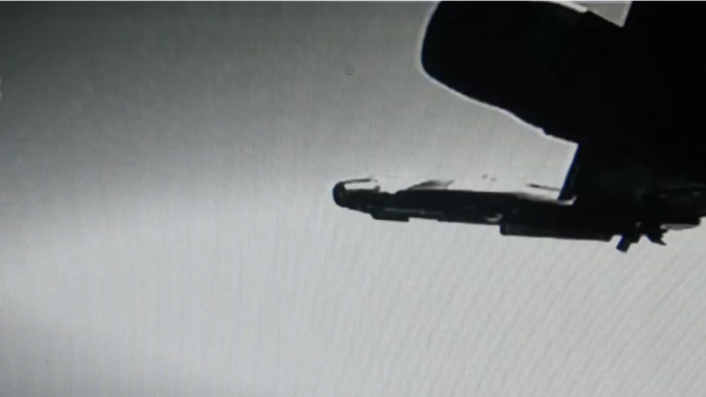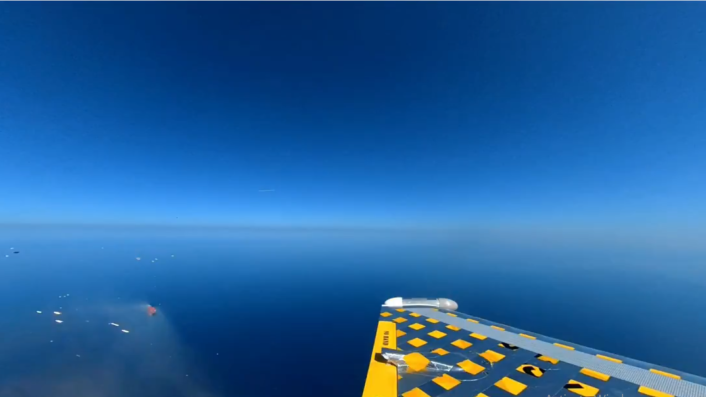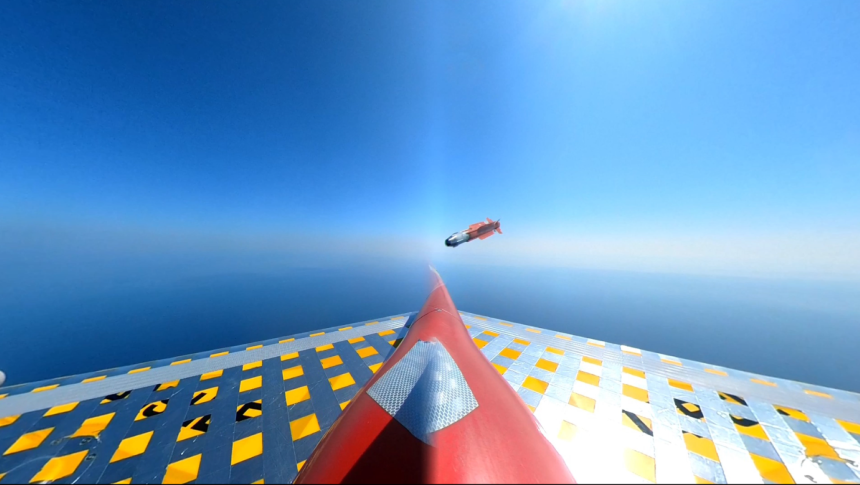France conducted the first live fire test of the MICA Next Generation, the evolution of the MICA air-to-air missile in service with the French Air and Space Force.
The French defense procurement agency DGA (Directorate General of Armaments) announced the first live-fire trial of the MICA NG air-to-air missile on Jun. 19, 2025, launched by a Rafale fighter. MBDA’s MICA NG would come in infrared and “electromagnetic homing” versions, according to the DGA, and the latest live-fire in the Mediterranean site of the DGA Missile testing Center of Expertise and Testing tested the IR version.
Held jointly by the DGA, MBDA, Dassault Aviation and the French Air and Space Force (FASF), the test marks the start of the live-fire campaign which will lead to the certification of the new weapon. The military authority has announced additional live-fire trials in the future, evaluating the weapon’s full engagement envelope and the entirety of its systems and subsystems.
These will “validate the full capabilities of the MICA NG, in its different versions and firing configurations, at different altitudes and flight speeds of the aircraft, including supersonic,” mentioned the press release. Interestingly, the missile’s seeker has been tested on a unique testbed meant for the Rafale, based on the Fokker 100 aircraft.
[#Essai 📋] MICA NG
La DGA procède au 1er tir de développement du missile MICA NG de @MBDAGroup depuis un Rafale ⤵️@Armees_Gouv @Armee_de_lair @MarineNationale @Dassault_OnAir pic.twitter.com/oodHfLGwo6
— Direction générale de l’armement 🇫🇷 (@DGA) June 20, 2025
The test
The image released by the DGA shows the instrumented variant of the MICA NG, inert and colored orange, behind a pilotless target drone fraction of a second before impact. A video showed the target drone being launched from a ground-based rail launcher, and in-flight footage on the Rafale as it launched the MICA NG from the right wingtip launcher.
The weapon can be seen striking the drone, with some pieces flying around when the two came in contact. Another camera on the target drone captures a side-view showing the MICA NG continuing to fly after the contact. This can be considered by all accounts a direct hit, as the live variant of the weapon is equipped with both direct hit and proximity fuses.

MICA and MICA NG
The existing MICA medium-range AAMs have two main variants, the IR-seeker MICA IR and a radar-homing MICA RF. MBDA specifies that the IR seeker in the MICA NG is actually a Passive Imaging Infrared (IIR) seeker, “surpassing the latest generation” of AAMs. The other variant uses an AESA (Active Electronically Scanned Array Seeker) seeker, providing “all-weather shoot-up/shoot-down capability.”
“IR MICA NG outperforms other BVR missiles with its unique stealthy interception capability, provided by its silent IR seeker,” MBDA says. “In short-range combat situations, with the combination of Lock-On-Before-Launch and Lock-On-After-Launch modes, together with excellent acquisition and tracking performance, authorise a 360° launch envelope.”

The DGA added that the “infrared and electromagnetic homing” feature “enhanced performance, notably thanks to its bi-pulse thruster [dual-pulse motor],” enabling the “Rafale to address all types of threats, both current and future.” Low flying, terrain hugging cruise missiles and drones, capable of autonomously changing direction and coordinating with each other in salvo fires, are likely to be its targets, informed by the experience in the wars in the Middle East and Ukraine.
“This new-generation weapon system will enable forces to face future threats that are more stealthy, more efficient and faster, and thus maintain operational superiority in contested airspace,” the DGA added. The missile has both short-range and BVR (Beyond Visual Range) capability, and while MBDA France has not specified its exact reach, it says it is 40% more than the current MICA missiles.
This launch “constitutes a major milestone towards the qualification of the missile and its integration into the Rafale,” enhancing the FASF’s and the French Navy’s (Marine Nationale) Rafales’ “interception, close combat and self-protection capabilities.” A first batch of 200 missiles has already been contracted.

A Vertical Launch (VL) MICA NG is also set to be acquired by the French Armed Forces, with a Jan. 2025 € 600 million contract to MBDA, Thales and KNDS, covering SAMs, self-propelled AD systems and counter-drone platforms. The first contract, awarded to MBDA France, involves the delivery of eight VL MICA NG launchers, along with missiles and spare parts, for the FASF. “France is set to operate nine VL MICA NG launchers by 2030, increasing to 12 by 2035,” as per Defence Industry Europe.
The MICA NG (Missile d’Interception et de Combat Aérien Nouvelle Génération) is a cutting-edge air-to-air missile developed by MBDA. Designed to equip the Rafale fighter aircraft, the weapon system is set to replace the MICA missiles that have been in operational service since… pic.twitter.com/itpRTtOuZ4
— GreeceDefence (@defence_greece) May 18, 2024
Fokker 100 Testbed for the Rafale and MICA missile
Interestingly, the DGA added that the latest launch required a significant amount of preparation, “including the design and implementation of several flight test campaigns carried out with the Fokker 100 test bench aircraft.” The DGA-EV (Direction Générale de l’Armement-Essais en Vol) led this phase “with strong involvement from other test centers.”
The 25-year-old Fokker 100 testbed is an interesting aircraft. It was acquired by the DGA in late 2015 and was modified to test systems and technologies meant for the Dassault Rafale. The Dutch-made plane made in the 1990s still has several years of life left in the airframe for the new intended role. It is also known as the Fokker 100 ABE-NG (Avion Banc d’Essais-Nouvelle Génération).
The aircraft was first displayed at the 2015 edition of the Paris Air Show held from Jun. 15 to 21 of that year. Meant to replace the Dassault Falcon 20, FlightGlobal had previously quoted director of DGA’s flight testing Claude Chenuil mentioning that the Fokker differs from the Falcon in terms of the multiple systems that can be integrated for testing simultaneously, reducing the time between flights.
🇳🇱 A very special F100!
🇫🇷 Fokker 100 ABE NG @ Bastille flypast
F-ZAFT is operated as a testbed for the Rafale fighter jet.
It is configured with a Rafale nose cone, a large test pod underneath the forward fuselage and hardpoints with (dummy) missiles under the wings.
The… pic.twitter.com/k8gFUh9Oux
— Menno Swart (@MennoSwart) July 16, 2024
“It [the Falcon] was dedicated to a single system, but because the Fokker is larger the plan is to carry out different tests at the same time,” Chenul told FlightGlobal.
The aircraft was modified by Sabena Technics and carries a Rafale nose section that houses the fighter’s Thales RBE-2 active electronically scanned array radar and front sector optronics equipment. “Hardpoints were added under the wings to allow the carriage of MICA air-to-air missiles and under the fuselage to carry systems such as the Reco NG reconnaissance pod,” AIN reported. “The aircraft will not be used for live fire testing, but for testing the seeker capability of the missiles,” Chenuil further told FlightGlobal.









